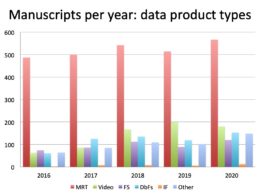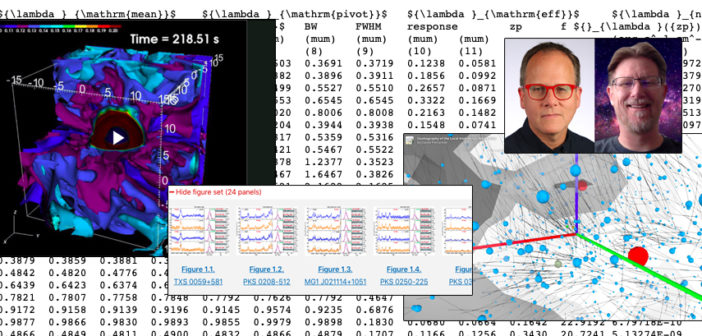What happens when you submit a scientific manuscript to AAS journals? While most folks are familiar with the peer review process, fewer people know about some of the additional reviews and work occurring behind the scenes at our journals. Here, we sit down to find out more about Dr. Greg Schwarz and Dr. Gus Muench, our two AAS Journals Data Editors.
A Critical Role
What, exactly, is a data editor? Ultimately, Greg says, “we’re in the happiness business.” Our two data editors aim to identify elements of authors’ manuscripts that involve data and help the authors to make those data accessible, attractive, long-lived, and useful to other scientists. Accessible data ultimately supports the American Astronomical Society’s underlying goal to enhance and share humanity’s scientific understanding of the universe.

Each year, our data editors process many hundreds of manuscripts containing machine-readable tables (red), videos (green), figure sets (purple), data behind the figures (cyan), interactive figures (orange), and other data products like data DOIs (blue). [AAS Journals]
Our data editors make sure that these products are standardized (e.g., the tables are in a machine-readable format, or software is properly cited), all the important data of the study are captured and available (e.g., if a light curve for a supernova is presented, a reader can easily obtain the data behind the figure), and links work and point to stable and long-lived storage locations for the data.
Gus and Greg also help enhance the way that authors present their data. As technology evolves, the data in scientific articles can be visualized in many more ways than just static images and tables; our data editors assist authors in leveraging animations, figure sets, interactive figures, and more. They also evaluate the accessibility of these products, making sure that figures are colorblind-friendly and captions contain best-practice descriptive language.
In short, by helping authors to tell their stories, Greg and Gus work to improve the publishing experience for authors and readers alike.
Exploring Unique Career Paths
Greg and Gus are both trained as PhD astronomers. How did they end up in their unusual roles?
AAS journals’ development of a data editor position more than 20 years ago was unprecedented. “There were some very forward-thinking people in the late 90s who got the ball rolling on this,” Greg says.
At the time, published astronomical data were primarily presented as long-form printed tables in the physical journal articles. Due to the inconsistency of how these tables were provided, the AAS took the novel step of seeking a trained astronomer to formalize and standardize those data so that other members of the community could more easily find and use them. Greg, then wrapping up a postdoc in data-heavy time-domain astronomy, was a natural fit for the job.
As AAS journals continued to advance their support for innovative ways to present data, the role of data editor became too involved for one person alone to handle. At that point, Gus came on board.
Prior to joining AAS journals, Gus’s decade-plus research-astronomy career had been slowly evolving. He started out as an observational astronomer collecting new data, but over time, he began to focus more on archival data. In the process, he delved deeper into the structure of archival data — how do you create, store, and use archival data? “I had a transitionary point where I was hired to work for the virtual observatory in the US,” Gus says. “I spent 5 years essentially doing user-facing professional outreach to get people to publish data and use archival data.” This experience set him up well for his current role.
Data Editors and You
So how does the presence of data editors at the AAS journals affect you?
If you’re an author submitting a manuscript to AAS journals that contains data, chances are good that Gus or Greg will take a look at your data products at some stage of the review process and make recommendations if they see ways to improve them! But the data editors’ work is also useful at much earlier stages in the publication process: they’ve produced and compiled a number of resources to help you prepare your manuscript and data products before submitting.

An interactive tool for visualizing time-series data is just one example of recent AAS journal innovation in how data are shared. [NASA/JPL-Caltech/AAS]
Do you have suggestions for how the AAS journals data editors could further help authors? Or ideas for how to improve the data presentation in AAS journals for readers? Our work is never done, and input from the community is the best way to keep improving. You can contact the data editors with questions or thoughts at data-editors@aas.org.



